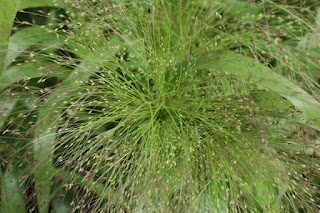So now we look at our hay with wary eyes. I looked on the Internet trying to find a picture of this grass. Unfortunately most of the pictures were of the grass uncut in a field or garden. I found some seed heads that did not look like the normal variety we see in our hay. Another Internet search found a picture of Switchgrass (panicum virgitum) and it looked like the stuff I was seeing.
 |
| Only our stuff was dried... |
Well VA Tech was giving a talk on the issue at the MARE center this week. Peggy decided to go and get some more information. You could also bring in samples to be checked. They could tell you the bad effects, but not how much or little of the grass could cause the problems. This happened about 10 years ago and caused the death of at least five horses. Beyond that the other effected horses cost about $10,000 each to treat. Nothing good.
They did talk about identifying the grass in the hay. It tends to be stockier and at the bulbs it angles. There is hair like stuff at the base of where a seed head would start. The sample Peggy brought was Panicum, but not the fall kind. Peggy and Mom looked at our hay the next day and did find fall Panicum.
 |
| Angling, with hair |
 |
| Panicum Pile :( |
Let me tell you it is so hard. Our hay guy is great because he takes payments, very unusual. Going with someone else means having to shell out a large sum at one time. But weighed against the possible liver damage of the horses... Yeah see the problem. Last night I could not fill the hay bags with the hay. I told Peggy that we need to feed it loose so they can easily pick through it. Then at night we can give them the clean hay that the 30+ year eats out of the hay bags. I believe we will send the end back once we get in touch with our supplier. He has cows that can eat it safely. The worst part is who knows when his grass will be safe again for horses.
 |
| I piece makes the whole bale scary |
Lets hope we can get some peace of mind soon.
yikes - that does not sounds like a very good situation at all, hopefully your approach works tho and the horses just pass it over :(
ReplyDeleteSo far they do leave it behind and we use a leaf vacuum to pick up anything left.
DeleteUgh - what a pain in the butt. A few years back I got hay with foxtail in it that tore my horse's mouth up. Not death dealing thank goodness, but having to negotiate returning hay, re-handling and replacing it is a ton of work. Glad you caught it sooner rather than later and hope the horses ate around it.
ReplyDeleteYuck foxtails are nasty. Before this we only worried about fescue when Rosemary was pregnant. Can't wait to be done with this hay!
Delete